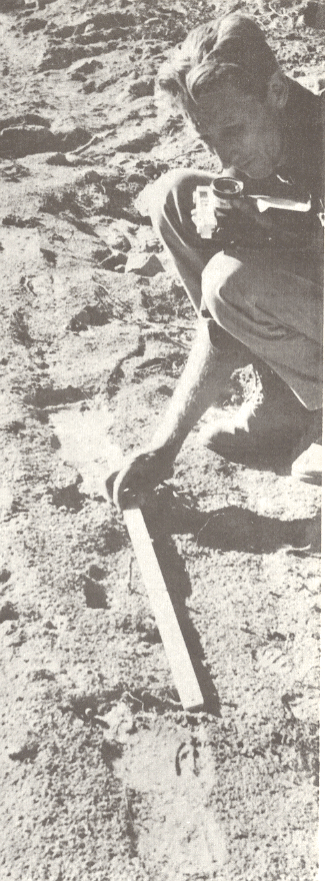
March 24, 2007

The Real Bigfoot and Genuine Bigfoot Tracks
Part 6: A Trail of Tracks in Print
by Mark A. Hall
A Trail of Tracks in Print
There exists a clear trail of success for the appearances of the fake tracks executed by the second set. The one photograph of an Oh-Mah track in Ivan Sanderson’s Abominable Snowmen is one of these fakes. By the time Sanderson made a trip through the West in 1959 the fakes had been liberally deposited on sandbars in Bluff Creek. He used the imprint of one of those fakes as an illustration in his book. For years afterwards he displayed an imprinted mold made from it as the footprint of Bigfoot. [39]

The tracks left on Blue Creek Mountain [- Onion Mountain], California, in 1967 were a long trail from the second set. They appeared in John Green’s books and were illustrated in many Bigfoot articles written by others.

Photographs of this fake appeared in books by John Napier and by Elwood Baumann, and in the one Rene Dahinden co-authored with Don Hunter. The silhouette of the fake track adorned the dust jacket of Kenneth Wylie’s book Bigfoot – A Personal Inquiry. [40]

Peter Byrne put a photograph of this fake into his book The Search for Bigfoot. The caption identified it as “one of three thousand prints found in the dust of a logging road in the Cascade Mountains.” [41]

I should note the significance of three books where these fake tracks did not appear. Roger Patterson did not put any image of them into his two books, the 169-page Do Abominable Snowmen of America Really Exist? published in 1966 and the 68-page Bigfoot – Volume 1 published in 1968. Grover Krantz likewise ignored these particular fakes when he wrote Big Footprints. The implication is that these two authors did not find them acceptable.
The tracks became a part of Bigfoot history. A part that can now be recognized and removed from any serious consideration of the topic.
Once mistaken for genuine Bigfoot tracks, there are two reasons why the fake footprints became so widely disseminated. There was money to be made by selling copies of casts and photographs. That began in the late 1950s as Bob Titmus offered copies of casts at $3.50 apiece. Others followed in later years. And readers about Bigfoot wanted to see what a track looked like for themselves. For that purpose the best images were, not surprisingly, the numerous fake images tramped out in controlled circumstances by people who wanted them to be seen and admired. It was done in places where poorly made fakes could be destroyed if they did not have the desired appearance.
The tracks were recognized as fake as early as 1960. But that knowledge was not widely shared at the time.
Tomorrow – Part 7: Hoaxing Revealed
Originally published in Wonders for December 2002 (Vol. 7 No. 4) pp. 99-125.
©2003 by Mark A. Hall. All rights reserved.
About Loren Coleman
Loren Coleman is one of the world’s leading cryptozoologists, some say “the” leading living cryptozoologist. Certainly, he is acknowledged as the current living American researcher and writer who has most popularized cryptozoology in the late 20th and early 21st centuries.
Starting his fieldwork and investigations in 1960, after traveling and trekking extensively in pursuit of cryptozoological mysteries, Coleman began writing to share his experiences in 1969. An honorary member of Ivan T. Sanderson’s Society for the Investigation of the Unexplained in the 1970s, Coleman has been bestowed with similar honorary memberships of the North Idaho College Cryptozoology Club in 1983, and in subsequent years, that of the British Columbia Scientific Cryptozoology Club, CryptoSafari International, and other international organizations. He was also a Life Member and Benefactor of the International Society of Cryptozoology (now-defunct).
Loren Coleman’s daily blog, as a member of the Cryptomundo Team, served as an ongoing avenue of communication for the ever-growing body of cryptozoo news from 2005 through 2013. He returned as an infrequent contributor beginning Halloween week of 2015.
Coleman is the founder in 2003, and current director of the International Cryptozoology Museum in Portland, Maine.
Filed under Abominable Snowman, Artifacts, Bigfoot, Books, Cryptomundo Exclusive, Cryptotourism, CryptoZoo News, Cryptozoologists, Cryptozoology, Evidence, Forensic Science, Hoaxes, Pop Culture, Sasquatch